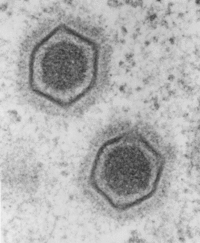Iridoviridae

Baltimore Classification
Higher order taxa
Virus; Iridoviridae (Family); Iridovirus
Species
Example- Chilo iridescent virus (IV6)
Description and Significance
The word Iridoviridae is derived from Iris, the Greek goddess of the rainbow. The 'rainbow-like' iridescence observed in heavily infected insects and pelleted samples of invertebrates iridoviruses gives the virus this name. This iridescence fcilitated the first detection of an iridovirus in 1954. Iridoviruses have since been isolated from both invertebrates and non-mammalian vertebrate hosts. These hosts are mostly found in aquatic or moist environments. Iridoviruses pose significant problems to aquacultural practices but they could potentially be used in the biological control of insect pests.
Genome Structure
The genome of the iridovirus is not segmented but contains a single molecule of linear double-stranded DNA. The compelte genome is 150000-28000 nucleotides long. The genome has a guanine+cytosine content of 30%. Double stranded DNA is circularly permutted. The genome has terminally redundant sequences that have direct terminal repeats. This structure is a result of the resolution of genome concatamers during DNA replication. Each virion contains a single copy of the linear dsDNA genome that ranges in size from 150 to 280 kbp, depending on viral species.
Virion Structure of an Iridovirus
The virions of iridovirus consist of a capsid and an internal lipid membrane. The capsid is not enveloped. The internal lipid membrane is located between the outer and inner protein shell. The capsid, or nucleocapsid, is round and exhibits icosahedral symmetry. the isometric capsid has a diameter of 120-140nm. Capsids appear hexagonal in outline. The virion has a complex capsid with a possible triangulation number of 147 and 1472 subunits. The shell contains lipid, but is protected by capsid proteins. Infected larvae and purified virus pellets produce blue to purple iridescence.
Reproductive Cycle of an Iridoviridae in a Host Cell
Studies of FV3 have helped to understand the replication of iridoviruses and this has become the model for iridovirus replication. Packaging occurs in the cytoplasm of infected cells but a nuclear stage is also present.
The virus particles enter the cell by pinocytosis and uncoatinf occurs. The viral DNA is transported to the cell nucleus where the host macromolecular synthesis is rapidly shutdown. Virally modified host RNA polymerase II initiates transcription. The parental DNA is used to produce genome and greater than genome length DNA. This becomes the template for cytoplasmic replication. The progeny DNA is transported into the cytoplasm where large concatamers of viral DNA are formed by recombination. Cytoplasm is also the site of transcription of very late transcripts. Contacemers are resolved into packaged lengths, possibly by a headful packaging approach. The virions exit the cell by budding or cell lysis.
Duplex DNA with single stranded 3' ends (A) is produced from origin dependent replication. These single stranded regions are capable of recombination within the same duplex (C) or with another DNA molecule (B). In this way, these 3' ends serve as primers for futher DNA replication. A large interlinked and replicating DNA concatamer is thus formed.
Transcription occurs in a temporal manner in three stages- immediate early, delayed early and late, as shown by studies of both vertebrate and invertebrate iridoviruses. There is both positive induction and some negative feedback on transcription at each leve by translational products of other temporal stages.
Viral Ecology & Pathology
Iridoviruses from the blackfly are found in two states, convert (inapparent) and patent (lethal), the ratios of each dependent on the environmental conditionsand host densities. The fat bodies and haemocytes are the intial sites of replication in a lethal infection by insect iridovirus and this leads to a systemic infection. Insects become flaccid and descent 7-10 days after infection although it could take 3 weeks or longer for the insect to die because of the infection.
Although frog embryos and larvae die within 15 days if innoculated with the virus, FV3 is now known to cause diseases in naturally occuring frog populations. FV3 can cause edema of tadpole tails but it does not seem to have an effect when introduced in adult frogs.
Many marine and freshwater fish are affected by LCDV-1, although the viral disease is nonlethal. The virus enlarges the host cells significantly, and the volume of a cell could increase by a factor of 106. Nonmalignant tumor-like growths and raspberry-like lesions are often observed in infected fish.
FV3 and LCDV appear to be non-lethal but high mortality rates have been observed amongst various frogs and fish populations, caused by other viruses of the Iridoviridae family.
